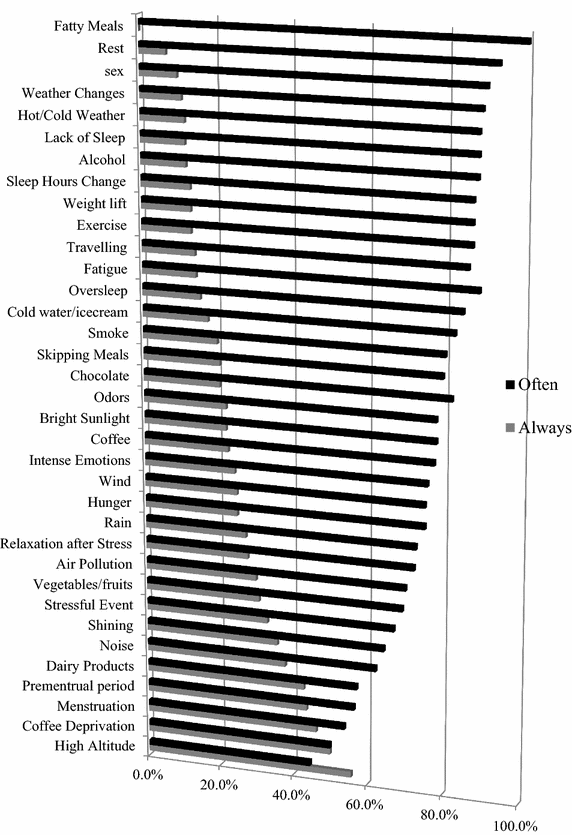Trigger factors in primary headaches subtypes: a cross-sectional study from a tertiary centre in Greece
- PMID: 26324056
- PMCID: PMC4553925
- DOI: 10.1186/s13104-015-1390-7
Trigger factors in primary headaches subtypes: a cross-sectional study from a tertiary centre in Greece
Abstract
Background: Previous studies have shown that common headache triggers contribute to the onset of headache attacks on predisposed individuals and are considered important in the prevention of headache. The aim of this study was to compare the different characteristics of triggers among the most common primary headache subtypes (migraine without aura, migraine with aura and tension type headache).
Methods: A total of 116 headache patients of the neurology outpatient department of a tertiary hospital in Athens were selected according to the criteria of the International Classification of Headaches-3nd Edition Beta. Patients were interviewed using a questionnaire that contained 35 potential trigger factors.
Results: The findings showed that migraine and tension-type headache patients report multiple triggers, on a frequent but variable basis. The most frequent triggers reported by all subjects were stressful life events followed by intense emotions. The same applies to both genders, as well as the three headache subgroups. Patients suffering from migraine with aura reported the highest mean number of trigger per person and the highest frequency in almost all the trigger categories. Furthermore, patients with migraine with aura were more likely to report the following triggers: oversleeping, premenstrual period, stressful life events, hot/cold weather, relaxation after stress, menstruation, wind, intense emotions, shining, hunger and bright sunlight. These associations were mostly independent of the sociodemographic characteristics and the presence of anxiety or depressive symptoms.
Conclusion: The sensitivity to trigger factors should be considered by both clinicians and headache sufferers.
Figures
Similar articles
-
Triggers of migraine and tension-type headache in China: a clinic-based survey.Eur J Neurol. 2013 Apr;20(4):689-96. doi: 10.1111/ene.12039. Epub 2013 Jan 28. Eur J Neurol. 2013. PMID: 23356519
-
Clinical characteristics of basilar-type migraine in the neurological clinic of a university hospital.Pain Med. 2014 Jul;15(7):1230-5. doi: 10.1111/pme.12402. Epub 2014 Mar 25. Pain Med. 2014. PMID: 24666545
-
Alcoholic drinks as triggers in primary headaches.Pain Med. 2013 Aug;14(8):1254-9. doi: 10.1111/pme.12127. Epub 2013 Apr 24. Pain Med. 2013. PMID: 23614946
-
Alcohol-induced headaches: Evidence for a central mechanism?J Neurosci Rural Pract. 2016 Apr-Jun;7(2):269-75. doi: 10.4103/0976-3147.178654. J Neurosci Rural Pract. 2016. PMID: 27114660 Free PMC article. Review.
-
Geographical Differences in Trigger Factors of Tension-Type Headaches and Migraines.Curr Pain Headache Rep. 2019 Feb 21;23(2):12. doi: 10.1007/s11916-019-0760-6. Curr Pain Headache Rep. 2019. PMID: 30790108 Review.
Cited by
-
Irregular meal and migraine headache: a scoping review.BMC Nutr. 2025 Mar 26;11(1):60. doi: 10.1186/s40795-025-01048-8. BMC Nutr. 2025. PMID: 40140884 Free PMC article.
-
Dietary trigger factors of migraine and tension-type headache in a South East Asian country.J Pain Res. 2018 Jun 28;11:1255-1261. doi: 10.2147/JPR.S158151. eCollection 2018. J Pain Res. 2018. PMID: 29988763 Free PMC article.
-
Kappa opioid signaling in the central nucleus of the amygdala promotes disinhibition and aversiveness of chronic neuropathic pain.Pain. 2019 Apr;160(4):824-832. doi: 10.1097/j.pain.0000000000001458. Pain. 2019. PMID: 30681985 Free PMC article.
-
Management of headache and associated factors among undergraduate medicine and health science students of University of Gondar, North West Ethiopia.J Headache Pain. 2016;17:56. doi: 10.1186/s10194-016-0647-4. Epub 2016 May 23. J Headache Pain. 2016. PMID: 27216280 Free PMC article.
-
Evaluation of Headache Trends among Undergraduate First Responders for Medical Emergencies at Saudi University in Riyadh, Saudi Arabia.Medicina (Kaunas). 2023 Aug 23;59(9):1522. doi: 10.3390/medicina59091522. Medicina (Kaunas). 2023. PMID: 37763644 Free PMC article.
References
-
- Vos T, Flaxman AD, Naghavi M, Lozano R, Michaud C, Ezzati M, Shibuya K, Salomon JA, Abdalla S, Aboyans V, et al. Years lived with disability (YLDs) for 1160 sequelae of 289 diseases and injuries 1990–2010: a systematic analysis for the Global Burden of Disease Study 2010. Lancet. 2012;380:2163–2196. doi: 10.1016/S0140-6736(12)61729-2. - DOI - PMC - PubMed
-
- WHO . Neurological disorders: public health challenges. Geneva: World Health Organisation; 2006. p. 77.
MeSH terms
LinkOut - more resources
Full Text Sources
Other Literature Sources
Medical
Miscellaneous


